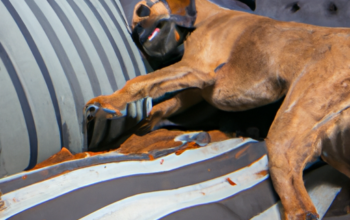Introducing a new dog into your home or social circle can be an exciting time, but it’s not without its challenges. Understanding the process and taking the right steps is crucial to ensure a smooth transition and foster healthy relationships among your canine companions.
In this guide, we’ll walk you through step-by-step on how to introduce dogs successfully by assessing their temperaments, choosing the right environment for introduction, managing their initial meeting, gradually increasing interaction time and ultimately nurturing a positive relationship between them.
Remember that every dog is unique with different comfort levels and behaviors when meeting other dogs. Being patient and observant will go a long way in ensuring a successful introduction. It’s important to understand that this process may take more time than anticipated – don’t rush it!
With careful planning, understanding each dog’s temperament and controlled introductions, you’ll create an environment where both dogs feel safe and comfortable with one another. Let’s dive deeper into these strategies to help you navigate through this journey of fostering harmonious canine relationships.
Assessing the Canine Temperaments
Before you even think about introducing two dogs, it’s crucial to deeply understand their individual temperaments. You’d be surprised at how much heartbreak and stress can be avoided if you just take the time to do this.
Canine behavior analysis is a critical tool in evaluating dog temperaments. It involves studying the animal’s reactions, interactions, and behaviors in various situations for you to gauge its personality traits effectively. This scientific approach helps identify key markers like aggression, fear, sociability, or independence that might significantly impact how well two dogs get along with each other.
Temperament testing methods are also essential techniques in assessing canine personalities. These methods may include tests like placing the dog in an unfamiliar environment and observing its responses or perhaps introducing new objects or people into its space. A detailed understanding of these methods will allow you to see what triggers anxiety or induces excitement, whether your pet prefers solitary activities or enjoys being around others.
By doing so, you’re not just guessing but making informed decisions based on empirical evidence gathered through systematic observation and testing before any introductions between dogs occur. Remembering that every dog is unique—just like humans—and understanding their idiosyncrasies is key for successful dog introductions.
Choosing the Right Environment
Imagine a calm, open space where your furry friends can meet for the first time without feeling cornered or overwhelmed. This is crucial in promoting a positive initial interaction between them. The concept of Environmental Familiarity plays an important role here. Choose a neutral territory, preferably outdoors – like a park or quiet street – that neither dog associates as their ‘territory’. This reduces territorial behavior and aggression that could potentially arise from introducing dogs in one’s own home.
The Space Set up also holds immense importance in this scenario. It should be spacious enough for both dogs to maneuver freely and have escape routes if they feel threatened or uncomfortable. Avoid tight corners and small rooms which might amplify any tension between them. In addition, having familiar objects such as toys or bedding can help reduce anxiety and make the environment feel more comfortable to both parties involved.
| Suitable Locations | Unsuitable Locations |
|---|---|
| Open parks | Tight corners |
| Quiet streets | Small rooms |
| Large backyards | Busy public places |
| Spacious indoor areas | Car interior |
| Neutral territories | One’s own house (if it’s associated with one dog) |
The Initial Meeting
Once you’ve chosen the perfect spot, it’s time for the moment of truth – the first encounter. But before you bring the dogs together, ensure they’re both in good health. A dog’s health can greatly influence its behavior and interactions with other dogs.
If one or both dogs aren’t feeling well, this could lead to unnecessary aggression or fear during their meeting. So, take them both for a check-up if needed to ensure they’re in peak condition.
In addition to checking on your dogs’ health, also pay attention to your own behavior as an owner during this crucial meeting. Dogs are extremely perceptive creatures and can easily pick up on their owner’s emotions and energy levels. Try to remain calm and relaxed throughout the process; any anxiety or nervousness you feel could translate into tension between the two dogs.
Furthermore, don’t force interaction between them but rather let it happen naturally while you closely supervise for signs of discomfort or aggression from either party.
Gradually Increasing Interaction Time
As you gently extend their time together, it’s important to remember that Rome wasn’t built in a day. It’s vital to take things slow and continually monitor the dogs’ body language during each interaction.
Watch for signs of aggression or fear such as raised hackles, growling, cowering, or other unusual behaviors. If you notice these signs, it may mean the dogs need more time to adjust before spending longer periods together. Conversely, positive indications like relaxed body posture, wagging tails, and playful actions are good signals that they’re getting comfortable with one another.
In addition to careful observation, incorporate reward-based training into your routine to encourage positive interactions between the dogs. When they behave well around each other – showing calmness or playfulness without any sign of hostility – reward them with praise or treats. This technique helps associate their companion’s presence with positive outcomes.
Gradually increase their interaction time but always ensure it ends on a good note – this way every encounter is something both dogs can look forward to next time.
Nurturing a Positive Relationship
Building a positive relationship between your furry friends requires patience, consistency and a whole lot of love. An excellent strategy to foster this bond is through ‘Rewarding Cooperation’. This means recognizing and reinforcing good behavior when they interact positively with each other. You could use treats, praise, or their favorite toys as rewards. Remember, the key is to make sure that both dogs associate the presence of the other with pleasant experiences.
As you reward cooperation, you’re also ‘Building Trust’ between your pets. This process involves spending quality time together where they can learn about each other’s behaviors and signals in a safe environment. It may be beneficial to have them engage in activities that they both enjoy such as playing fetch or going for walks together. Building trust also means intervening when necessary to prevent any aggressive behaviors from escalating which could potentially harm their relationship.
Here’s a quick guide on how:
| Steps | Description |
|---|---|
| 1.Reward Cooperation | Use treats, praises or toys for positive interactions |
| 2.Build Trust | Spend quality time together engaging in activities they both enjoy |
| 3.Intervene When Necessary | Prevent aggression escalation by stepping in at the right moment |
| 4.Consistency Is Key | Maintain regular habits and routines for stability and predictability |
Remember that every dog has its own personality and pace; some might take longer than others to adjust so it’s important to remain patient throughout this journey.
Frequently Asked Questions
What should I do if one of the dogs is not neutered/spayed?
Recognizing the neuter/spay importance is crucial. If one dog isn’t neutered/spayed, anticipate potential behavioral changes like aggression or marking territory. It’s best to consult a vet for advice before introducing them to other dogs.
How can I introduce a dog to a household with cats or other pets?
To introduce a dog to a home with cats or other pets, consider Pet Personality Compatibility. Gradually introduce them, letting your pets establish territory. Monitor interactions closely to ensure safety and comfort for all animals.
What dietary changes should I consider when introducing a new dog?
Consider implementing Diet Transition Techniques when introducing new foods to your dog’s diet. Monitor for allergic reactions closely. Gradually mix old and new food, increasing the new food ratio over 7-10 days for smooth adjustment.
How to handle the introduction if one dog is significantly older or younger than the other?
Address age-related anxiety by introducing the younger dog slowly, ensuring the senior dog’s acceptance. Limit their initial interactions, gradually increasing them over time. Respect your older dog’s space and energy levels during this process.
How to introduce a rescue dog with an unknown past to an existing pet?
Unsure about your rescue dog’s past traumas? Begin with controlled introductions to avoid personality clashes. Use a neutral space to meet, keeping leashes loose and allowing for sniffing at their own pace.
Conclusion
In the grand tapestry of life, your dogs’ introduction is but a single thread. However, this thread holds the potential to weave an enduring bond or fray at the edges. So tread carefully and be patient.
Remember, successful introductions require understanding your dogs’ temperaments, choosing an appropriate environment, managing first meetings, and gradually increasing interaction time.
Through these steps, you’re not just introducing two animals – you’re nurturing a lifelong friendship.



